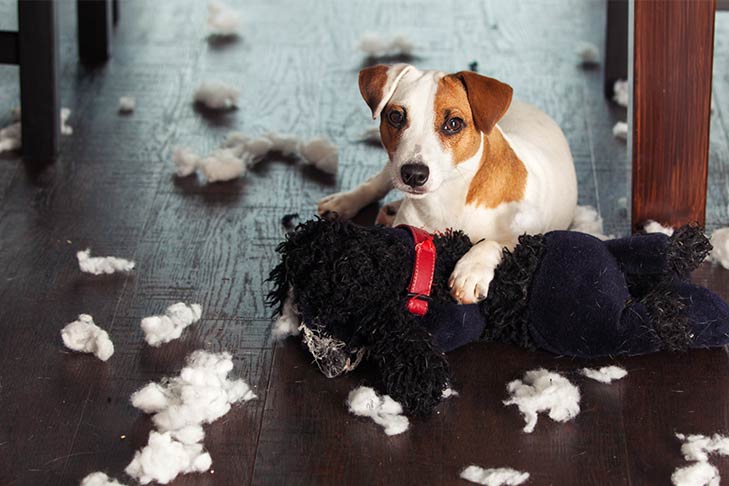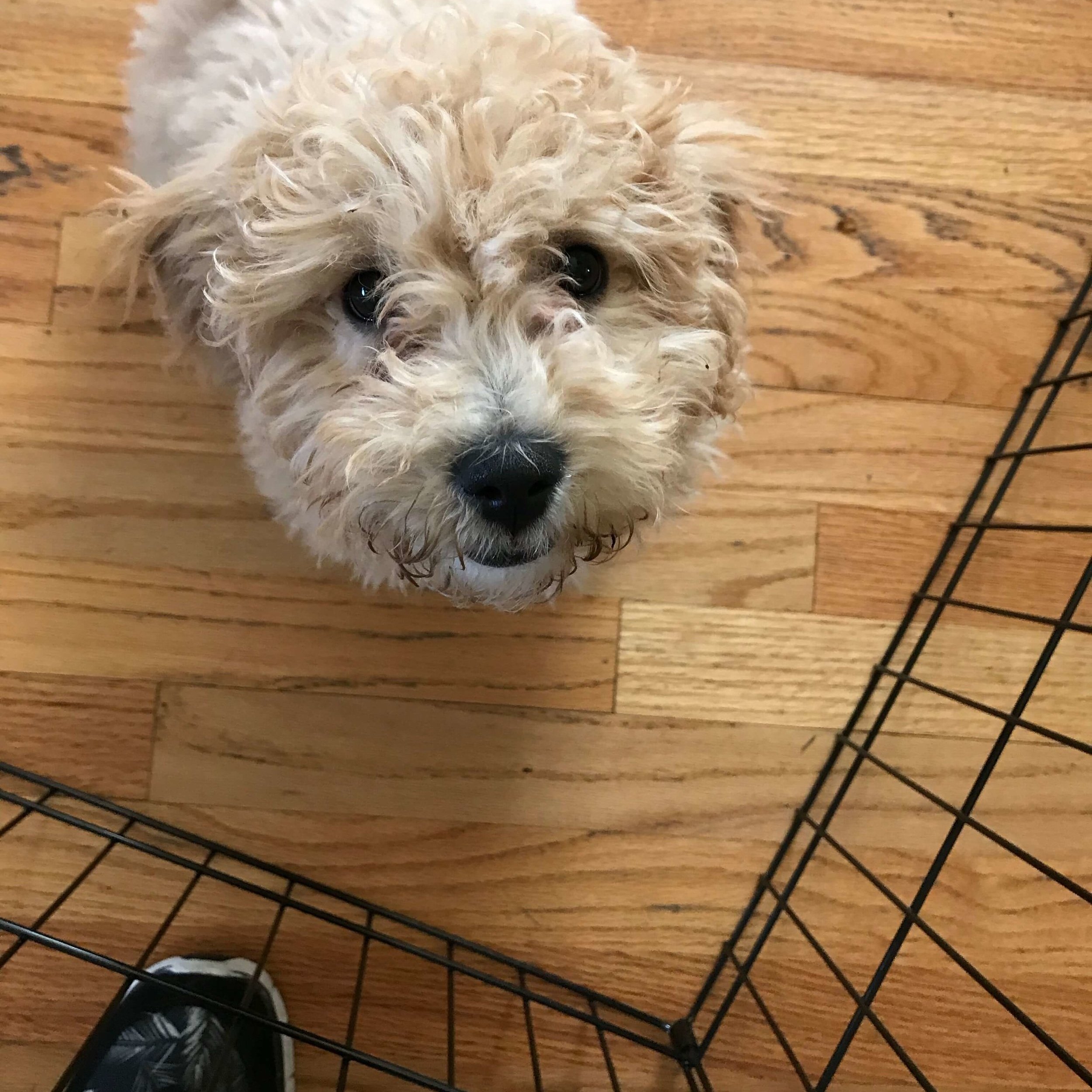
Separation anxiety in dogs can be describe as an experiences of fear and panic over being left alone or separated from a preferred caregiver or companion. This is why it’s highly recommended to have your dog trained at 10 weeks of age. Dogs with full-blown separation anxiety may:
- whine,
- howl,
- bark in cycles
- destroy doors or door-frames
- follow you around
All in an attempt to follow you, sometimes even ending up with bloodied paws; they may also defecate or urinate when you’re absent or refuse to eat any food they are left with. Some dogs will even throw themselves through glass windows in an attempt to break free from confinement or follow their owners!

What Causes Dog Separation Anxiety?
People often adopt a puppy or adult dog on a holiday or weekend when they have extra time to spend with them. Some even take time off work when adding a new dog to their family. SMP PAWS offers services to compliment the forward thinking Pet parent that realizes they need help from a professional. This is an excellent idea, in principle, but it’s also important that you use that time to prepare your new dog for being left alone when you eventually go back to work. This can be done by getting your dog into the routine that will take place once you’re back at work in advance of it actually happening.
Otherwise, your new puppy or dog may get used to having your company all day long and get upset when you are suddenly no longer present. And, without precautionary measures in place, this could lead to the development of canine separation anxiety, which once full-blown, is a particularly difficult dog behavior issue to solve.

How to Prevent Dog Separation Anxiety
Once established, separation anxiety in dogs can be difficult to rehabilitate and can wreak havoc in your day-to-day life: angry neighbors complain about the noise, landlords sometimes threaten eviction, and your social life may suffer because it’s impossible to leave your dog alone. To avoid these unfortunate outcomes, think about how you can get your dog accustomed to spending time by themselves and incorporate this into your new routine:

How many hours will your dog be alone?
What time will your dog get up/go to bed?
What time will the dog’s walks be?
What time will the dog eat?
Can someone return at lunchtime or during the day, to provide a toilet and play/training opportunity?
What measures can you put in place when you go back to work to help ease the dog into the transition?
The more prepared you are, the better your chances of helping your dog transition to how life will be once you’re back at work. Luckily, dogs are creatures of habit, and establishing a routine is easy.

How to prevent separation anxiety: Keeping a puppy in a playpen is helpful for teaching it to spend time by itself.
Create a Schedule that Includes Routine Confinement
When you first bring a new puppy or dog home, your initial task is to help them feel safe in your house and safe with you.
Put their bed by your bed, or if you don’t want your dog in the bedroom, put a gate up on your bedroom door and the bed just on the other side of it. Creating other safe spaces for them in the main living areas of your home is also essential, so providing a crate, bed, or another designated area that they can claim for themselves is extremely important.
For puppies, erecting a playpen/exercise pen where they can hang out nearby their new family members is essential for reducing potential dog anxiety. An added bonus of confinement areas is that they keep your new puppy and dog out of trouble when you’re not actively supervising them and help tremendously with potty training.
Lastly, think about taking your new dog with you when you go out if possible, or have someone sit with them at home if you can’t. Take some time off work, if you can, to help your dog settle in during this time. Have in mind what things will ultimately be like on a daily basis for your dog and work towards getting your dog used to that new routine.
Alone Training Prepares a Dog for Being by Themselves
Once your new dog is settled in, it’s best to start gradually easing them into the routine that will be followed when you go back to work. This routine should include some form of ‘Alone Training.’ Alone Training helps acclimate your dog to being in your home when no one is present and is an essential part of helping them feel secure when they inevitably find that they are by themselves during work hours.
You may think your dog can handle being by themselves, but unless you try leaving them alone first, you will not know. Alone training can help you determine whether your new puppy or dog can tolerate being alone without having a panic attack, so definitely make time for it! All that is involved is pretending to go through your leaving routine without actually disappearing for very long–at least, not at first.
Mock Leaving Routine: Alone Training Guidelines

You will only need about 5-10 minutes to get started. Always make sure your dog has had a bathroom break and has had a walk to expend any excess energy they may have before getting started on the following steps below:
- STEP 1: Put on your coat/pick up your keys/get ready. Use a specific phrase that tells your dog that you’re leaving but will be back soon (‘I’ll be back’ or ‘See you later’). Go out, and immediately come back in again. Ignore your dog completely until they settle themselves into a down (down = laying down).
- STEP 2: Say your phrase, go out again and immediately return. Ignore your dog completely until they settle themselves into a down again. Repeat this as many times as it takes until you see your dog has stopped being at all interested in what you’re doing, and either become absorbed in the kong or is in a dozed relaxed state.
- STEP 3: Repeat as above but now go out and wait 5 seconds. Return and repeat until your dog is relaxed in a down. Gradually increase this time to 10 seconds, working up to 30 seconds and 1 minute, as you see that it gets easier and easier for your dog to relax.
NOTE: You may progress through all of this in one or two sessions. Or, if your dog becomes hyper-alert and worried when you go out, it may take you a week and several sessions a day. A lot depends on your individual dog.
Slowly Build Up to Leaving for Longer Time Periods
Once you’ve reached the 5-minute mark, you might like to start walking away from the house, and then turn and walk back to the house again. Repeat this until your dog is completely relaxed. Work up to 10-15 minute increments. If you have a corner shop near you, go and get the paper or some milk. By the time you reach this sort of length of time, the number of repetitions you’re going to be able to do each day is much fewer.
Try to get a couple of sessions in each day. The good news is that the first 15 minutes of being left are the hardest time for any dog, and the time when separation anxiety in dogs is most likely to kick in. If you’ve reached this length of time with no problems, it’s very likely you’re in the clear!

